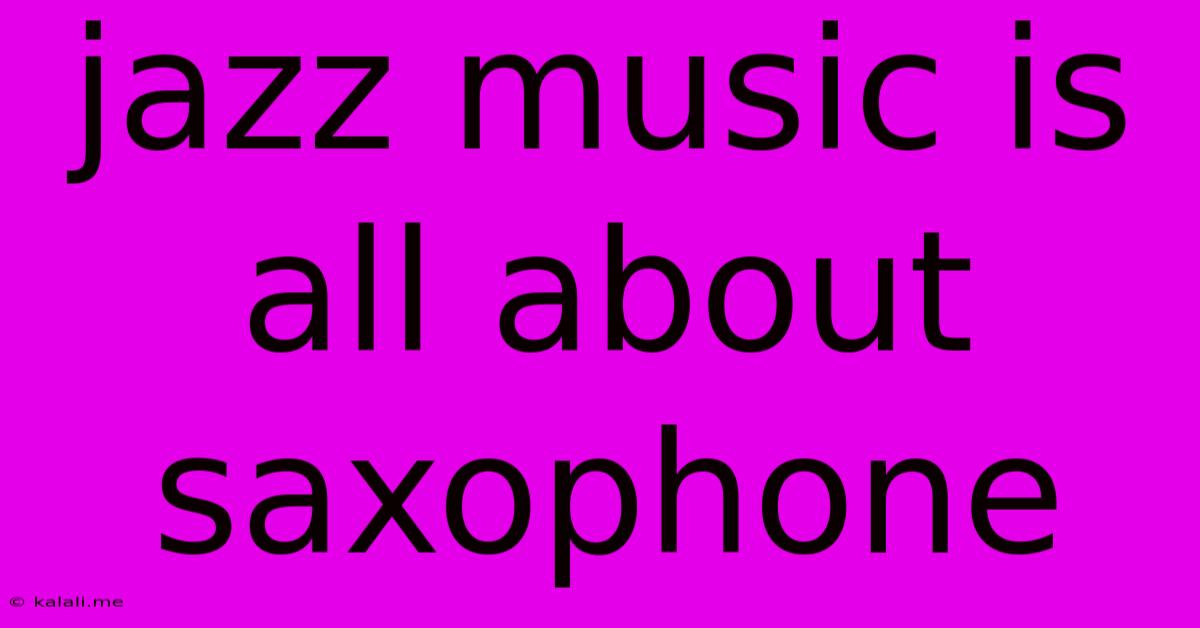Jazz Music Is All About Saxophone
Kalali
Jun 09, 2025 · 3 min read

Table of Contents
Jazz Music: More Than Just a Saxophone Solo
While the saxophone's wailing notes and improvisational prowess are undeniably iconic in jazz, reducing the genre to simply "saxophone music" is a significant oversimplification. This article delves into the rich tapestry of jazz, exploring its diverse instrumentation, rhythmic complexities, and improvisational spirit, showcasing why it's so much more than just a saxophone solo. Understanding the true essence of jazz requires appreciating its multifaceted nature.
The saxophone, with its expressive timbre and versatility, has undeniably played a crucial role in shaping jazz's sonic landscape. From the soulful sounds of Coleman Hawkins to the innovative techniques of John Coltrane, the instrument's contribution is undeniable. However, to limit jazz to the saxophone is to ignore the foundational contributions of other instruments and musical traditions.
The Roots of Jazz: Beyond the Saxophone
Jazz's origins lie in the melting pot of New Orleans, blending elements of African rhythms, European harmonies, and American blues. Early jazz bands often featured instruments like the cornet, trumpet, trombone, clarinet, and piano, all playing vital roles in creating the genre's unique sound. The rhythmic drive of the banjo and drums provided the backbone for improvisations, while the piano's harmonic complexity added depth and sophistication.
The saxophone's prominence emerged later, becoming a key instrument in the swing era and beyond. But even during its rise, other instruments remained equally important. Consider the iconic trumpet solos of Louis Armstrong, the piano virtuosity of Art Tatum, or the rhythmic brilliance of drummers like Max Roach. These musicians, along with many others, demonstrate the genre's diverse instrumental landscape.
Improvisation: The Heart of Jazz
The heart of jazz lies in its improvisational nature. While the saxophone often takes center stage for solos, improvisation isn't limited to any single instrument. The entire ensemble engages in a dynamic interplay of musical ideas, building upon each other's phrases and creating a spontaneous, evolving musical conversation. This collective improvisation is a key element that distinguishes jazz from other genres. Pianists, bassists, drummers, and horn players all contribute to this improvisational interplay, showcasing the collaborative nature of the music.
Subgenres and Evolution: A Diverse Soundscape
Jazz is not a monolithic genre. It has branched into countless subgenres, each with its own unique characteristics and instrumental preferences. Bebop, cool jazz, hard bop, modal jazz, free jazz, and fusion all showcase diverse approaches to instrumentation and improvisation. Some subgenres might feature the saxophone prominently, while others might emphasize different instruments. This continuous evolution and diversification of jazz proves its resilience and adaptability, further highlighting its complexity.
Conclusion: A Rich and Varied Musical Tradition
In conclusion, while the saxophone is undoubtedly a significant and often featured instrument in jazz music, to define the genre solely by this instrument is to miss its rich history, diverse instrumentation, and most importantly, its improvisational heart. Jazz is a complex and multifaceted musical tradition, a testament to the power of collective improvisation and the fusion of diverse musical influences. Appreciating jazz truly requires listening beyond the saxophone and embracing the full spectrum of its musical beauty.
Latest Posts
Latest Posts
-
Four Way Light Switch Wiring Diagram
Jun 09, 2025
-
To Be Honest I Was Just Going To
Jun 09, 2025
-
Third Party Host File Too Big
Jun 09, 2025
-
Internship Can Lose My Free Time
Jun 09, 2025
-
Laminate Flooring Vs Hardwood Vs Engineered
Jun 09, 2025
Related Post
Thank you for visiting our website which covers about Jazz Music Is All About Saxophone . We hope the information provided has been useful to you. Feel free to contact us if you have any questions or need further assistance. See you next time and don't miss to bookmark.